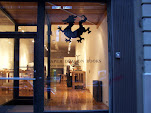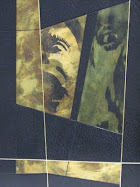
....so, as ever, a client came in with prints asking for a full leather binding in a matter of days, and of course I said "no problem!"......
Single sheets were separated into sections, and overcast, rounded and backed, covered, ready for finishing, and because of the tight deadline , the ends were put down, and the book pressed.
This is one time when finishing "on the book",will be an advantage.
The brief for finishing was a little vague
"....do something art deco style...a few lines here and there..."
Its actually not that vague at all, because I knew exactly what she wanted immediately.
One of the simplest patterns in an art-deco style, completed on all objects, from cigarette lighters to buildings, is the old intersecting lines that make random but not random squares and rectangles....!
Now before all you art historians and artists out there gasp in disgust as I reduce a whole art period to a "hack-merchants hand-book :guide to the arts", this situation must be approached in a pragmatic manner.
The situation being the strict timeline, allowing 1 day for the design and completion of the book.
I don't have time to do homework, or an elaborate design using other elements of the period.(fans,concentric circles,geometry!)
From a bookbinders point of view, the easiest thing I can do is something using straight line pallets.So there it is, decided without thinking, the pattern made-up as I went along, which is easy enough with good eyesight and a straight edge.
Admittedly, the design would have been improved with more effort and time, but in times of pressure, you have to know your limitations, pull out a trick, and get it done.
Not an artist and without any formal training in art, so much of designing book covers, whether period or design binding(with the exception book structure),bookbinding for me at the moment seems to be an amalgum of tricks-meaning, the manipulation of materials using methods such as colouring,dying,printing,sanding;then also the completion of pattern work through onlay,inlay and tooling.
The more tricks you learn, the better you become at translating that initial image you get in your head of the way you would like the object to look, into to something that feels finished.(I guess that's common sense)
What I'm trying to say is that you don't have to be born with an aptitude for art to be a good bookbinder, but that through practise, trial and many errors, you can teach yourself to be not only a bookbinder, but an artist too.
This is how I have learned to work.
Just ask my first teacher, who handed me a tube of acryllic paint and told to me use it to colour the edge of my book.Of course, he was extremely amused to see that I had put on a layer of paint a few millimeters thick.....not a clue!!
If you are interested in art-deco bookbinding, you might try this book....
Art Noveau and Art Deco Bookbinding:French Masterpieces 1880-1940
(Alastair Duncan, Georges De Bartha)









No comments:
Post a Comment